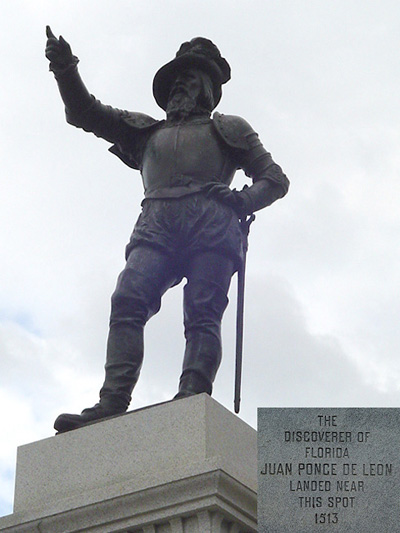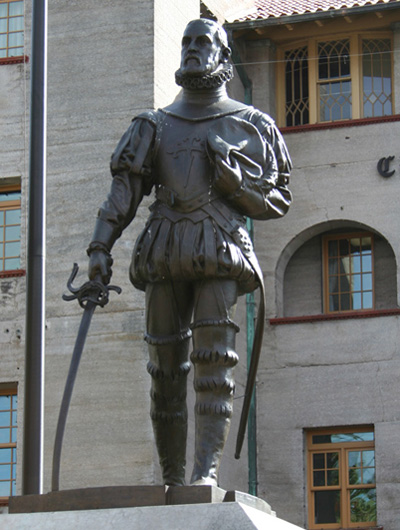

San Agustín, St. Augustine (4) |
 |
 |
|---|
Sources: Photos by WTL© (2007 and 2008). Images: The photo on the left shows Juan Ponce de León (1460—1521), who probably landed in what is now St. Augustine in 1513. He stood 4'11" tall. This statue stands prominently between the Plaza de Armas on the north and the A1A Ale Works brewery and restaurant on the south on Avenida Menéndez, which runs north-south along the city's sea wall (el malecón) on the Matanzas Inlet. The statue also stands next to the old slave market (officially: Public Market) at the eastern head of the principal town square, the Plaza de la Constitución. The statue on the right is of Menéndez de Avilés (1519—1574), and it stands in front of Flagler's first hotel in St. Augustine, the Ponce de León, which is now home to Flagler College, a private liberal arts college founded in 1968. (1) Ponce de León is associated with Columbus's second voyage, various Caribbean "discoveries" and conquests, and the death of Indians on Puerto Rico, Cuba, and in Florida. He named the peninsula and all the land north and west of it La Florida because he landed on the Florida coast in the Eastern season. (By the way, Pascua Florida Day, April 2, is a legal holiday in Florida.) He died in 1521 when attempting to establish a settlement on the Caloosahatchee River in Charlotte Harbor, Florida. The Spanish colonists there were attacked by Calusa Indians; Ponce de León was fatally shot with a poisoned arrow. For another humanities view of Ponce de León, please link to => the Cummer Museum in Jacksonville. For still another humanities view, this one a contemporary 2009 view, see: => The major glass artist Therman Statom's exhibition on "Stories of the New World," which the artist says deals with the contemporary implications of Ponce de Leon's search for the legendary fountain of youth in Florida in 1513. At a minimum, Statom's major multi-media exhibition on this theme shows that Ponce de León's actions five centuries ago have creative humanistic vitality today. (Statom has pertinent ancestors in his background.) (2) Pedro Menéndez de Avilés is considered by the citizens of Avilés, Spain, to be one of their most illustrious historical figures. From an early age he was a skilled marine pilot and sailor. From 1556 on he was promoted to the rank of admiral (Capitán general de la Armada), and he was a member of the prestigious knightly (chivalric) Order of Santiago: notice the cross on the armor on his chest. According to Justo Ureña y Hevia, chronicler of Avilés, Menéndez de Avilés was "an extraordinary seaman, an intelligent and brave soldier, a sensible and generous governor, a skillful diplomat, a peacemaker, a traditional devout Spanish Christian ... a wise man, a veritable Renaissance figure of his age ... fond of family, honest, noble and truthful..." (St. Augustine, Florida; San Agustín, Florida; Avilés, Spain; Avilés, España. Avilés, Spain: 2001, n.p Copyright © 2001, Foto Angelín, S.C.). He also massacred the French Huguenots (i.e., Protestants) at Matanzas inlet. For further images and a discussion of Menéndez de Avilés and his historic landing in St. Augustine in 1565, see: => Menéndez. Humanities Questions: (1) What similarities and differences do you notice between the two statues? Associate your answer with the information above or with what you may find in other resources. (2) What are your first and second reactions to Therman Statom's exhibition at the Orlando Museum of Art (OMA) in 2009? |
|---|
 |